All gain, no pain: how to avoid injuries from running, skiing, swimming, cycling, football, rugby, yoga …
One minute you’re pushing your body to its limits, the next you’ve gone too far and you’re stretched out with an icepack. Sports pros explain how to escape pains, sprains, tears and swellings
Prevention, in exercise as in so many other things, is better than cure. When you start a new sport or workout regime, it’s easy to let endorphins or sheer competitiveness get the better of you – but tweak a ligament or ping a hamstring, and there’s every chance you’ll feel it for months, even years. With that in mind, we’ve assembled an all-star team of coaches and athletes to talk you through the most common injuries for whatever type of training you’ve just taken up – and the measures you can take to avoid them. And please remember, if all this sounds intimidating, that the best way to prevent a whole host of later-life issues is simply getting off the couch in the first place. Let’s go …
Running

The simplest form of exercise – which makes it easy to overdo. “In my experience, the three most common running issues are achilles soreness, iliotibial band pain and shin splints,” says Tom Berry, a personal trainer and sprint coach at the University of Exeter. “And all three stem from training too much too soon. The achilles tendon, for instance, is the strongest and longest tendon in the body, and does an exceptionally large amount of work controlling ground impact, while the iliotibial band [AKA the ITB] is a long fibrous tissue that assists in laterally stabilising the knee. Shin splints is an umbrella term for numerous lower leg issues, but people often use it to refer to soreness in the tibialis anterior muscle – the outside of the shin.”
Managing training volume – or more specifically, the number of times your feet hit the ground – is key to avoiding all three conditions. “The good news is that the body adapts,” says Berry. “If you gradually expose your body to higher volumes of running, you develop your capacity to run further without injury. Recovery is vital, so for most runners I recommend having 48 hours between running-based training sessions. Coaching can also help – for example, lateral shin splints often come from excessive heel-striking [ie, hitting the ground heel first], which is a technique issue that can be fixed. Strength training can also keep your body resilient – for instance, you can perform exercises that strengthen the glutes [buttocks] and abductors to help them control your knee, instead of relying on the ITB to do it. Simple exercises such as calf raises are also a great way of strengthening the calf muscles to reduce the likelihood of achilles pain, and are a staple of any rehab program.”
Football
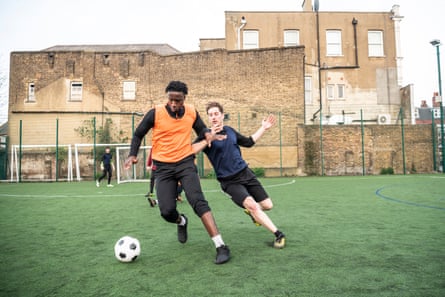
You might not move like Lionel Messi on the five-a-side pitch, but you can at least get the same injuries as him. “Adductor tears are some of the most common injuries among football players,” says Rayen Monzer, a professional footballer based in Poland. “This happens because they’re small but important leg muscles – and often overlooked in strength training. Adductors [which pull inwards, as opposed to abductors, which pull away] tend to compensate for other weak muscles, and so can easily get overtired and tear.” Making sure your glutes are “switched on” can help – excessive sitting can put these big muscles to sleep, and waking them up is key. Warm up with “fire hydrants” – get on all fours with your wrists under your shoulders, your knees under your hips, and then lift one leg and rotate like a dog doing … you know what. You can also squeeze your glutes at the top of a squat to feel them burn. “Better cleats or insoles in your shoes will help with comfort and control,” says Monzer. “But don’t rely on them.”
Tennis
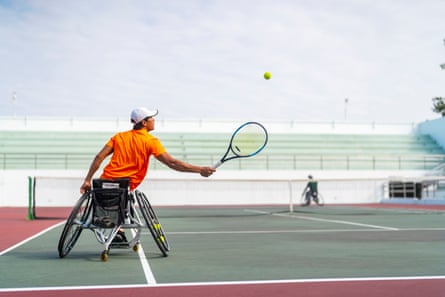
Tennis elbow, or pain caused by tiny tears and inflammation around the bony outside of your elbow, isn’t an ailment exclusive to tennis players – lots of repetitive arm movements can cause it – but it will certainly be aggravated on court if you’re unprepared. “One way to prevent it is to use a racket with the right weight, balance and grip size for you,” says Marc Massad, a professional tennis (and pickleball) coach. “But doing exercises that strengthen the forearm muscles can also be beneficial. Tennis players are often prone to shoulder injuries because of repetitive overhead serves – exercises focusing on shoulder mobility and stability can help in prevention.” Try external rotations: attach a resistance band to an anchor at waist height, then hold the band one-handed and rotate it in an arc against the resistance. “The final thing to worry about is ankle sprains from quick lateral movements,” says Massad. “Appropriate footwear can help, but so can balance exercises.”
Swimming
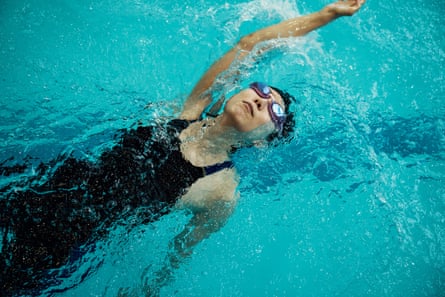
Swimmers have a whole pool of sports-specific ailments, but one of the most annoying isn’t an injury at all. “Swimmer’s ear” is the common term for an infection caused by water trapped in the ear canal. Prevent it by wearing earplugs or rinsing your ears with clean water after swimming – and then you can worry about “swimmer’s shoulder” and “swimmer’s knee” – common overuse injuries that can be the result of poor stroke mechanics. “Swimmer’s shoulder covers a variety of problems causing shoulder pain that may include rotator cuff impingement or tears, biceps tendinitis and bursitis – basically, swelling in the joints,” says Chloe Rafferty, a swim coach and the event director at LoveSwimRun. “You can prevent these issues by perfecting your technique and working on muscle strength in the shoulders and surrounding muscles with banded exercises such as pull-aparts, reverse flys, rows, front raise, lateral raise, external and internal rotations.” Swimmer’s knee, meanwhile, comes from repeated loading of the joints at unnatural angles. “Our legs are not really designed to kick and bend with our feet turned outwards,” says Rafferty. “Avoid this one by working on technique, varying your stroke, performing mobility and stability exercises. If you do one thing to help prevent swimmer’s knee, try lunges – including the front, reverse and lateral varieties.”
Weight training
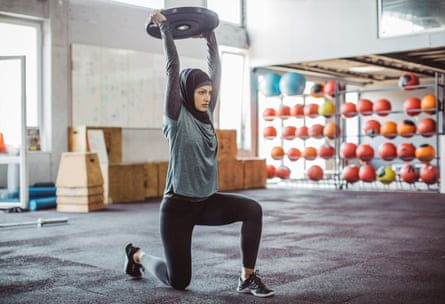
Lifting might seem to come with an element of risk, but it’s actually a fair bit less injurious than other sports – if you’re smart about it. “The good thing about weight training is that it’s mostly non-chaotic – unlike rugby, it doesn’t involve someone else running into you,” says the strength coach Joseph Lightfoot. “So it’s a super-low-risk activity, if you understand your own body and what you’re asking of it. The most common issues for most people are their lower back and shoulders. For the lower back, core work can help – think planks – but it’s also important to dial in lifting form, preferably with a coach. For shoulder health, one thing that seems to really help is keeping to a 2:1 ratio of pulling to pushing – so for every press-up, you do two ‘rowing’ style exercises. A good warmup is also key: we use the Ramp framework at my gym – raise body temp, activate muscle, mobilise joints and potentiate (or wake up) the muscles.”
Incidentally, if you’re wondering what the deadliest exercise is, it’s almost certainly the bench press: a 2003 study tracking mortality statistics found that out of 25 reported lifting deaths, 22 came from bench or other “supine” exercises – most of them in home gyms. Get a spotter if you’re going anywhere near “failure”.
Skiing

Assuming you’re wearing a helmet – you are doing this, right? – the next thing to worry about is your legs. “The most common ski injuries are to the anterior cruciate ligament, or ACL,” says Dr Matthew Perry, a physical therapist. “The ACL is a crucial stabiliser of the knee joint, and often injured in skiing through falls, crossing skis or with incorrect landings. ACL injuries can range from strains to complete tears.”
The best way to prevent them is with prehab exercises done weeks – or even months – before you get on the slopes. “Focus on strengthening the muscles of your hip and lower body,” says Perry. “Exercises such as squats, lunges and plyometrics for the legs – for instance, jumping versions of the lunge and squat – are all helpful. Investing in well-fitting ski boots and bindings that are correctly adjusted to your skill level can also significantly reduce the risk.” Shoulder dislocations are also common, due to poles getting stuck behind the body – while falls or collisions can lead to fractures of the collar bone or upper arm. “For resilience, the SkiErg machines now found in many gyms can help train the motions of skiing,” says Perry. “But overhead pressing with a barbell or dumbbells can also help build strength and bone density in the shoulders. You can also enrol in ski lessons to learn proper technique – especially how to fall safely.”
Circuit training
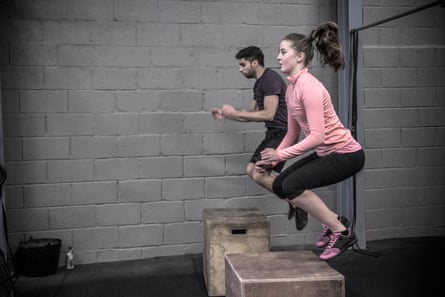
CrossFit, F45, Hyrox and the like all come with varying degrees of competitivity – great for burning extra calories, not so good if it encourages you to push too hard. “If I’m being honest, many injuries happen because people lift with their ego – trying to shift heavier weights than their bodies are capable of lifting while maintaining perfect form,” says Jana Barrett, a fitness and movement coach who specialises in working with people over 40. “People think that they will be perceived as slackers if they stop, and the ‘no pain, no gain’ philosophy is very much prevalent.” Here, the fix is to be realistic about your limitations and not push too hard.
“That said, there are a couple of common issues I see,” she continues. “The first is tight and weak hip flexors – these will cause pain to the point where people cannot do simple activities like getting out of the car. The causes of these are numerous – sitting down for long periods of time and then loading the tight hips with heavy deadlifts is very common. An easy and super-fast fix for tight hips is a mobility-based warmup: movements such as shin box switches, shin box extensions, leg swings, tabletops and bridges are fantastic.” Another problem – also relevant to runners – is having underactive glutes, which can lead to pain in the hips (because the hip flexors take too much of the strain) and in the lower back. “Men in particular are often quad-dominant, meaning they don’t know how to fully engage the glutes and rely heavily on the big quad muscles in the front of their legs,” says Jana. “The best fix for this is glute isolation exercises and activation movements before training sessions. Light hip thrusts, bridges and tabletops are all great.”
Yoga
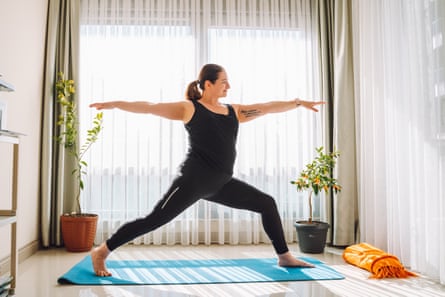
Considering yoga’s relaxing reputation, classes can get surprisingly strenuous – but even then, the most likely injuries might surprise you. “Knee injuries are among the most common injuries that arise during yoga practice,” says the yoga instructor Iana Varshavska. “Some poses can be relatively straightforward for some people, but an injury risk for others. For instance, in the classic lotus pose, rotation should occur in the hip joints, not the knees or ankles – so people who push through when they don’t have the hip joint structure to master the pose risk injury to their knee cartilage. Similarly, the hero pose isn’t suitable for everyone: people with bulky ankles can often perform it more safely with props. Generally, ensuring that your knees and feet are aligned in the same direction helps prevent traumatic twists in the joint – but employ knee pads or a yoga blanket to alleviate pressure on the joint if needed.”
Cycling

Although it’s a much lower-impact activity than running, cycling can still cause knee pain in the unprepared – it just comes in different flavours. “The most common knee pain issue encountered by cyclists is patellofemoral pain syndrome – which typically presents an ache at the front of the knee, specifically around the kneecap,” says Dr Brent Wells, a chiropractor who regularly treats cyclists. “It happens when your kneecap rubs against your thigh bone instead of gliding smoothly over it, which can damage the tissue under the kneecap and cause pain. Incorrect saddle or pedal adjustments on the bicycle can exacerbate the issue, but to avoid it you strengthen your quadriceps and hamstrings on non-cycling days with squats, lunges, leg presses, hamstring curls or step-ups.
Patellar tendinitis, often called ‘jumpers’ knee’, can also result from repetitive stress placed on the kneecap tendon during cycling, causing tiny tears in the tendon and leading to inflammation and pain.” Again, strength training can help – but the best plan is to ease into any increase in training volume gradually.
Rugby
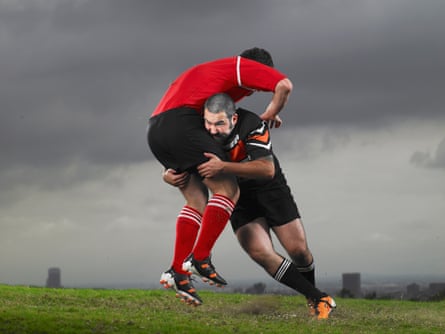
Obviously, the collision-heavy nature of the game makes rugby rife with injuries – but you’re not entirely safe if you make the switch to the minimal-contact version. “Shoulder injuries, including dislocations and acromioclavicular joint separations, are prevalent in rugby, as the shoulder is often the first point of contact with the ground after a tackle,” says Perry, the physical therapist. “Exercises, especially rotational ones, can help – use movements such as the ‘around the world’ dislocate with a stick or band as a warmup to improve mobility. [For this, take a wide grip on a stick – or use a light resistance band – then pass it over your head and behind your back to feel a stretch in your shoulders.] Exercises like the ‘banded chop’ – both low to high and high to low – can improve your shoulders’ ability to absorb impact.” If you’ve switched to touch rugby, hamstring strains are probably the biggest concern due to the explosive sprints and sudden stops inherent in the game – especially if you’re going straight from the car park to the pitch. Add movements such as the single-leg deadlift (without weight) to your warmup, and Romanian deadlifts to your warmup if you do one. Oh, and if you’re playing regular rugby, get a mouth guard.
Source: TheGuardian
